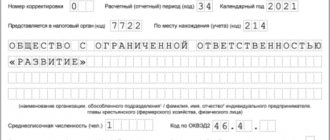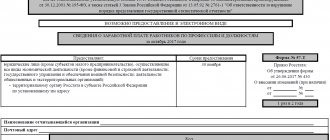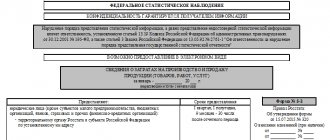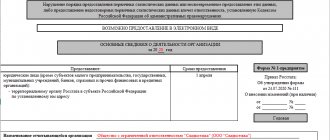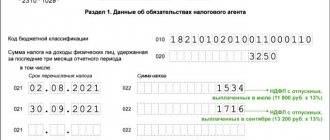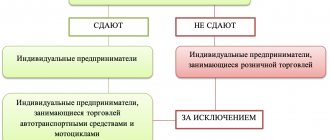From the fourth quarter of 2022, all companies must use the new form Calculation of insurance premiums (DAM) , KND 1151111 . In the article we will tell you when you need to submit the calculation, show a sample of filling it out and give detailed instructions on how to fill it out correctly.
The frequency of presentation is quarterly . All companies and individual entrepreneurs must report using the DAM form if they are insurers of pension, medical and social insurance for hired personnel. The RSV form for 2022 was approved by Federal Tax Service order No. ММВ-7-11/470 dated September 18, 2022, as amended by Federal Tax Service order No. ED-7-11/751 dated October 15, 2022.
Deadline for submitting the report according to the DAM form
The quarterly calculation of insurance premiums is submitted to the tax authorities no later than the 30th day of the month following the reporting period. If the established day for submitting the report falls on a weekend, then in accordance with the law it is postponed to the first working day (clause 7, article 6.1 of the Tax Code of the Russian Federation).
For 2022, the following deadlines for providing quarterly calculations have been established:
- for 2022 until January 31, 2022 (the 30th is a day off)
- for the first quarter until May 4, 2022 (April 30 is a day off)
- half a year before August 1, 2022 (July 30th and 31st are weekends)
- 9 months before October 31, 2022
Entrepreneurs running peasant farms do not submit quarterly reports; the deadline for submitting the annual report is set, as for other organizations, no later than January 30 of the following year. But since the 30th falls on a Sunday, the deadline is moved to the next working day, January 31, 2022.
What is insurance premium calculation?
The calculation of insurance premiums - ERSV or RSV (the extra letter in the first abbreviation corresponds to the definition of “single”) - is completely different from the reports of the RSV-1 and RSV-2 forms that were submitted to the Pension Fund until 2022.
Why? Because in connection with the introduction of all rules for working with insurance premiums (except for payments for injuries), previously contained in various laws, into the Tax Code of the Russian Federation in 2017, control over their accrual and payment passed to the tax authorities. That is, all reporting on contributions, which was previously submitted to 2 funds (PFR and Social Insurance Fund), began to be submitted to the Federal Tax Service. Since insurance premiums in such a situation turned out to be just part of tax payments, rational actions in relation to the reporting generated on them were:
- creating a summary report form that combines the data that was previously entered into 4 forms:
- RSV-1 - in relation to contributions to the Pension Fund and the Compulsory Medical Insurance Fund accrued by the majority of employers;
- RSV-2 - regarding payments to the same funds, but accrued by the heads of farms;
- RSV-3 - in relation to contributions aimed at additional social security for employees of certain categories;
- 4-FSS - regarding social security contributions for disability and maternity insurance;
There is little new in the content of the consolidated DAM in comparison with the reports made for funds. It has been shortened by excluding:
- the results of settlements with each of the funds at the beginning of the year and at the end of the reporting period;
- data on documents for payment of contributions;
- personal information about the length of service of employees.
That is, the report on contributions submitted to the Federal Tax Service has acquired an appearance close to that of a traditional tax report, while retaining the features inherent in reporting on insurance contributions previously submitted to the funds.
Method of submitting the report - on paper or via the Internet
Since 2022, the rules by which the possibility of submitting a declaration in electronic or paper form have been determined have changed. From the 1st quarter of 2022 in accordance with clause 4 of article 80, clause 10 of art. 431 of the Tax Code of the Russian Federation establishes a new limit on the number of employees :
- companies with more than 10 employees are required to provide a report in electronic form, previously this parameter was 25 people
- companies created during the reporting period, including through reorganization, are required to report electronically if the number of employees exceeds 10 people, and not 25, as was previously the case
Legal entities and individual entrepreneurs with fewer than 10 employees can choose the method of submitting the report independently: submit the calculation on paper in person, send it by registered mail with a list of attachments by mail, or submit it via electronic communication channels.
Filling out the DAM by employers on UTII or simplified tax system
Organizations or individual entrepreneurs that operate under a simplified taxation system or are payers of a single tax on imputed income may also have employees, which means they are required to submit calculations on a general basis, and they are concerned about the question of how to correctly fill out the RSV certificate. 1. What are these features that simplifiers need to take into account? Tax officials spoke about this in Letter No. GD-4-11 dated December 28, 2017 / [email protected] It, in particular, says that organizations that pay contributions at the general rate and at the same time apply the simplified tax system or UTII must fill out Appendix 1 to Section 1 of the RSV indicating one payer tariff code from those listed below:
- «01»,
- «02»,
- «03»,
since they correspond to the same category code of the insured person “NR”. Tax officials also explain that all tariff codes used by payers are specified in Appendix No. 5 to the procedure for filling out the form. It is also necessary to take into account that in field 200 of section 3 it is necessary to indicate the category code of the insured person in accordance with Appendix No. 8 to the filling procedure. The tariff code and the category code of the insured person must correspond to each other.
Control ratios when checking calculations
The Tax Service has changed the rules for checking control ratios (CR) of accrued amounts in the calculation of insurance premiums. Now the actions of the inspection bodies are regulated by letter of the Federal Tax Service No. BS-4-11 / [email protected] dated 02/07/2020. In the document, all changes are presented in the form of a detailed table. The new CS make it possible to better compare the amounts of payments accrued under employment contracts to employees not only with the minimum wage established by the region, but also with the average wages in certain industries for the previous period. This technique will make it possible to more effectively identify “black” salaries. In total, the list of control ratios has been reduced, but at the same time it has become more effective.
In Kontur.Externe, checks for new control ratios are already built in: if an error is detected, the system will not allow you to send the calculation.
Most of the report's benchmark ratios are evaluated according to the rate code. If an error is detected, the inspector sends a notice of non-compliance, which must be corrected within a specified time frame.
Calculation according to form 6-NDFL for 9 months of 2022
The calculation in form 6-NDFL for 9 months of 2022 is submitted to the tax authorities in the form approved. by order of the Federal Tax Service of Russia dated October 14, 2015 No. ММВ-7-11/ [email protected]
The change in the form and format of 6-NDFL is planned only from 01/01/2021 (for more details, see the article “The Federal Tax Service will change the form of 6-NDFL”).
Let us recall the basic principles and features of filling out a report in “1C: Salary and Personnel Management 8” edition 3.
Formation of calculations according to form 6-NDFL in the program is carried out automatically.
To correctly generate the calculation, it is necessary that the program contains:
- all income received by individuals during the tax period is reflected;
- information on the right to tax deductions (standard, professional, property, social, advance payments for personal income tax) has been entered and the actual deductions provided have been reflected;
- The amounts of calculated and withheld tax were calculated and taken into account.
Title page
The date of signing the report indicated on the title page affects the automatic completion of the calculation in Form 6-NDFL, namely, the completion of line 080 of Section 1.
Line 080 “Amount of tax not withheld by the tax agent” is filled in according to the program’s accounting data determined as of the date of signing the report.
Thus, the signature date on the title page must be greater than or equal to the date of payment of income for the last month included in the reporting period. If on the date of signature the entire salary has been paid, line 080 will be zero.
Section 1
In Section 1, the indicators are formed on an accrual basis from the beginning of the tax period.
For each tax rate, separate blocks of lines 010–050 are filled in. Lines 020–045 are formed by the date of receipt of income.
In the 1C: Salaries and Personnel Management 8 program, edition 3, the date of receipt of income is determined as follows:
- for income in the form of wages (income codes 2000, 2530) - as the last day of the month for which income was accrued (or the date of dismissal, if the employee was dismissed);
- for other income, the date of receipt of income is according to the payment date specified in the income payment document (Statement to the bank; Statement to the cash desk; Statement through the distributor; Statement to the accounts).
To analyze income by the date of actual receipt of income, use the report Summary certificate 2-NDFL (section Taxes and contributions - Reports on taxes and contributions), fig. 5.
Rice. 5
Section 2
In Section 2 of the 6-NDFL calculation, information about the actual income received and the tax withheld from this income is filled in.
The section is filled out according to the deadline for transferring the tax - in which reporting period (quarter) the deadline for transferring the tax falls (line 120), the operation should be included in the calculation for such a period.
Let us recall that the lines of Section 2 reflect:
- line 100 - date of actual receipt of income;
- line 110 - the tax withholding date is the date of actual payment.
In the program, tax is withheld using payment documents (statements). The amount of tax withheld in the statement is calculated automatically. And in the event of a discrepancy between the planned payment date specified in the accrual document and the actual date in the statement, when posting the Statement document, the date of receipt of income for income accounted for by the payment date is redefined by the date indicated in the statement. For example, in the Vacation document, the planned payment date was indicated as 09/30/2020, but vacation pay was actually paid on 10/01/2020, the date of receipt of income in this case will be 10/01/2020.
To analyze the total amount of withheld personal income tax, use the Withheld personal income tax report (section Taxes and contributions - Reports on taxes and contributions).
Line 120 reflects the date no later than which personal income tax must be transferred. For example, if this is a temporary disability benefit (including a benefit for caring for a sick child), vacation pay, then the transfer period is until the end of the month in which such income was paid. All other income, including wages, is the next day after tax is withheld. If the tax payment deadline falls on a weekend, it is postponed to the next working day.
The actual date of transfer is not reflected anywhere in the report. But it is important to control the actual dates of personal income tax transfer and the dates in line 120, since the data is verified by the Federal Tax Service with the tax agent budget settlement card (CRSB NA). If the date on line 120 is less than the date of actual payment of the tax amount (line 140), then during the inspection the inspection will reflect that the deadline for transferring personal income tax may have been violated, and, most likely, the organization will be charged fines and penalties.
Line 130 reflects the generalized amount of income actually received on the date indicated in line 100. This line is not included in the control ratios of the indicators of the calculation form, i.e. the line is not checked against anything, it is for reference.
Line 140 reflects the generalized amount of tax withheld on the date indicated in line 110. The tax amount is indicated excluding the personal income tax refund amount.
Information about the income actually received and the tax withheld from this income, for which three dates simultaneously coincide (the date of actual receipt of income, the date of tax withholding and the deadline for transferring the tax), are summarized and indicated in one block of lines 100–140.
If at least one of the dates does not match, income and tax withheld from it are reflected separately, i.e., a separate block of lines 100–140 is filled in for them.
To check and analyze the data in Section 2 of the 6-NDFL calculation, use the report Check section. 2 6-NDFL (section Taxes and contributions - Reports on taxes and contributions).
Deadline for submitting the 6-NDFL report
In accordance with the Tax Code, a report in form 6-NDFL for 9 months of 2022 must be submitted no later than November 2, 2020 (clause 2 of Article 230 of the Tax Code of the Russian Federation).
1C:ITS
For more information on preparing calculations using Form 6-NDFL in 1C programs, see the reference book “Reporting on personal income tax” in the “Legislative Consultations” section.
You can submit all necessary regulated reporting to regulatory authorities remotely, without visiting regulatory authorities, using the 1C-Reporting service built into 1C. The service works both in the cloud and through 1C:Link
.
From the editor. What to pay attention to when preparing “salary” reporting for 9 months of 2022, see also in the video recording of the lecture dated September 24, 2020 on the 1C:ITS website on the 1C:Lecture Hall page. The video recording is available for everyone to watch.
Separate divisions and branches
Separate divisions and branches that have a separate current account must provide calculations of insurance premiums to the local tax authority (clause 11 of Article 431 of the Tax Code of the Russian Federation). Since 2022, having a bank account has become a determining condition . Thanks to this modification, compliance of the Tax Code of the Russian Federation with the law on pension insurance was achieved, in which registration of a unit as an insurer is possible only if it has a separate current account.
For companies with separate divisions without a current account, which in the period 2017-2019. had the right to submit reports on insurance premiums to the local tax office, there were two options for action:
- Open a current account and continue reporting according to the old scheme.
- Submit to the tax authorities an application for deprivation of the division's authority to provide consolidated reporting, which includes information on the branch's accruals at its location.
Thus, in accordance with paragraphs. “a”, “c” clause 85 art. 2, part 3 art. 3 of Law No. 325-FZ, from January 1, 2022, only those separate divisions that make payments in favor of employees and have a separate current account can transfer insurance premiums and provide a declaration on them.
Reflection of expenses not subject to insurance premiums
The Federal Tax Service of Russia, in Letter No. GD-4-11/ [email protected] , explained how the payer must reflect in the DAM the amount of expenses and payments in favor of employees who are not subject to contributions. Such expenses are listed in Article 422 of the Tax Code of the Russian Federation and they must be included in reporting if they are recognized as an object of contributions. And all payments that are not subject to taxation do not need to be indicated in the calculation.
As a result, the policyholder must determine the taxable base as the difference between payments accrued in favor of individuals, subject to insurance premiums, and amounts exempt from them. This is the value that needs to be entered into the report to avoid errors. An example of such payments is a child care allowance for up to 1.5 years; the employer must indicate it. Since, according to the provisions of Article 420 of the Tax Code of the Russian Federation, such a payment is subject to compulsory social insurance, but according to the provisions of Article 422 of the Tax Code of the Russian Federation, it is exempt from taxation.
Calculation form and procedure for filling out the DAM form
In order to report on social contributions for the fourth quarter of 2021, you will have to use a new form approved by Order of the Federal Tax Service of the Russian Federation dated October 15, 2020 N ED-7-11/ [email protected]
Read more New form of the RSV 2022
The form of calculation has become simpler, but the new changes cannot be called drastic. It is most convenient to fill out the document in the following order: first, fill out the title page, then Section 3 and the rest of the appendices, and only at the very end proceed to filling out the first section.
Title page
The main innovation of the title page is the appearance of a field to reflect information about the average number of personnel. This innovation freed companies and individual entrepreneurs from submitting an independent report on their headcount to the Federal Tax Service.
Let's look at line-by-line filling.
TIN - 10-digit taxpayer number (12-digit for individual entrepreneurs)
Checkpoint - a 9-digit code assigned by the inspection where the declaration is submitted
The correction number is “0—” for the initial submission of the report, and the serial number of the correction for the updated report. Billing period - indicate the period code (see table)
| Taxable period | For legal entities and individual entrepreneurs | In case of reorganization (liquidation) |
| I quarter | 21 | 51 |
| half year | 31 | 52 |
| 9 months | 33 | 53 |
| year | 34 | 90 |
By location (accounting) (code) - the full list is given in Appendix No. 4 to the Filling Out Procedure, the most common are “120” for individual entrepreneurs and “214” for organizations.
The name of the organization is the full name of the taxpayer from the constituent documents.
Average headcount - indicates the number of personnel, which is calculated in accordance with clauses 76-79.11 of Rosstat Order No. 711 dated November 27, 2022.
OKVED2 code is a value from the OKVED2 classifier corresponding to the type of activity being carried out.
The following is a block to be filled in in case of reorganization (liquidation) of an organization .
The contact phone number is displayed with the country and city code. All numbers are written in a row without spaces or other symbols.
The number of sheets of the declaration is reflected , and, if available, the number of sheets of supporting documents.
Finally, the full name of the person certifying the accuracy and completeness of the information provided .
Signature
and
date .
Title page
Section 1
If the company made payments to its employees during the reporting period, then number 1 is indicated on line 001 “Payer type (code)”; for those who did not make payments, code 2 is provided. Accordingly, in the first case, the corresponding accruals should be indicated in lines 031-033 , in the second – zero values are entered.
for lines 111-113 . This was done to be able to reflect reimbursement of expenses in connection with temporary disability of employees in the calculation, even in cases where wages were not accrued.
Zero reporting should consist of a title page, Section 1 without appendices, which will indicate code 2, and Section 3 without table 3.2.
Section 1 consists of 9 appendices.
If during the reporting period the company applied several tariffs, then Appendix 1 to Section 1, as before, is filled out in several copies. The tariff code is indicated in accordance with the changes made in the classifier. Please note that the new form excludes codes 02 and 03. For those who apply the basic tariff for calculating insurance payments, code 01 is provided, which is indicated regardless of the chosen taxation system. Also, codes 04 and 05, which were entered in the case of using reduced tariff rates, have been removed from the register. Due to changes made to the legislation, such benefits have been terminated.
The following codes were entered into the register during the year:
| New code | Who points |
| 17 | Organizations from the unified register of residents of the Special Economic Zone in the Kaliningrad Region (Federal Law dated January 10, 2006 No. 16-FZ) |
| 18 | Russian companies that produce and sell their animated audiovisual products, regardless of the type of contract and (or) provision of services (performance of work) for the creation of animated audiovisual products |
| 19 | Payers of contributions with the status of a participant in a special administrative region (Federal Law of August 3, 2018 No. 291-FZ), who pay ship crew members for the performance of labor duties. Vessels must be registered in the Russian Open Register of Ships |
In Subsection 1.1 and 1.2 of Appendix 1 there is line 045, which is intended to form the amount of expenses accepted for deduction that are related to the receipt of income under the contracts listed in clause 8 of Art. 421 Tax Code of the Russian Federation. This line reflects expenses that have documentary evidence, as well as those that are accepted for deduction in the established amounts, regardless of the presence of documentary evidence.
In the new form of Calculation of insurance premiums in Appendix 2, a new line “Payer's tariff code” has appeared. Now, when using different tariffs simultaneously, this section will need to be filled out on several sheets, similar to Appendix 1. A new line 015 to reflect the number of people from whose payments insurance payments are accrued.
block 001-006 is intended to indicate charges for each individual tariff. Lines 070-090 indicate the total amounts for all applicable tariffs. Line 055 is intended to indicate the tax base from which contributions are calculated to stateless persons at a rate of 1.8%.
Appendix 5 has been developed to calculate compliance with the conditions for the use of reduced tariffs by IT companies in accordance with paragraphs. 3 p. 1 art. 427 Tax Code of the Russian Federation. When filling out a section in the new DAM, you must use new tariff codes. row 060 has also been added to the table to reflect information about company registration in the special zone resident form.
Added Appendix No. 5.1, which is filled out in case of applying a reduced tariff.
Appendix 6 is also intended to determine the legality of applying a reduced tariff for non-profit organizations using the simplified tax system and tariffs established by paragraphs. 3 p. 2 art. 427 Tax Code of the Russian Federation.
Appendix 7 is filled out by organizations that are engaged in the production of animation and audiovisual products using the reduced tariff established by paragraphs. 6 paragraph 2 art. 427 Tax Code of the Russian Federation. The new edition has expanded the list of codes (see Appendix No. 7 of the RSV)
Appendix 8 is intended for information on temporarily staying foreign citizens who pay contributions at a rate of 1.8%. Previously, such information was reflected in Appendix 9.
Appendix 9 is filled out by insurers who have employees who are undergoing training or working in student groups. Pension contributions are not calculated from these payments. In the previous edition, Appendix 10 was allocated for such policyholders.
Section 2
This section of the Insurance Premium Calculation form is entirely intended for peasant and farm households. The new changes affected only Appendix 1, where when indicating the personal data of members of the household, it will now be necessary to enter passport data, gender and date of birth in full. Completing this section is not particularly difficult.
Section 3
The form in question is intended to reflect personalized information. For subsection 3.2.2, a new coding has been developed that establishes the basis for calculating contributions at an additional tariff and in accordance with working conditions.
New codes of insured persons in subsection 3.2.2
| Code | Name |
| 110 | Those employed in the types of work specified in clause 1, part 1, art. 30 400-FZ, for payments for which an additional tariff is applied (clause 1 of Article 428 of the Tax Code of the Russian Federation) |
| 120 | Those employed in the types of work specified in clauses 2–18, part 1, art. 30 400-FZ, for payments for which an additional tariff is applied (clause 2 of Article 428 of the Tax Code of the Russian Federation) |
| 131 | Those employed in the types of work specified in clause 1, part 1, art. 30 400-FZ, class of working conditions - harmful, subclass of working conditions - 3.1 |
| 132 | Those employed in the types of work specified in clause 1, part 1, art. 30 400-FZ, class of working conditions - harmful, subclass of working conditions - 3.2 |
| 133 | Those employed in the types of work specified in clause 1, part 1, art. 30 400-FZ, class of working conditions - harmful, subclass of working conditions - 3.3 |
| 134 | Those employed in the types of work specified in clause 1, part 1, art. 30 400-FZ, class of working conditions - harmful, subclass of working conditions - 3.4 |
| 140 | Those employed in the types of work specified in clause 1, part 1, art. 30 400-FZ, class of working conditions - dangerous, subclass of working conditions - 4 |
| 231 | Those employed in the types of work specified in clauses 2–18, part 1, art. 30 400-FZ, class of working conditions - harmful, subclass of working conditions - 3.1 |
| 232 | Those employed in the types of work specified in clauses 2–18, part 1, art. 30 400-FZ, class of working conditions - harmful, subclass of working conditions - 3.2 |
| 233 | Those employed in the types of work specified in clauses 2–18, part 1, art. 30 400-FZ, class of working conditions - harmful, subclass of working conditions - 3.3 |
| 234 | Those employed in the types of work specified in clauses 2–18, part 1, art. 30 400-FZ, class of working conditions - harmful, subclass of working conditions - 3.4 |
| 240 | Those employed in the types of work specified in clauses 2–18, part 1, art. 30 400-FZ, class of working conditions - dangerous, subclass of working conditions - 4 |
Section 3
Filling out the RSV for 2022
The RSV form contains several sheets, but only those containing indicators are included in the calculation. Most organizations and individual entrepreneurs must fill out the following form sheets: Title, Section 1 with Appendix 1 (subsections 1.1 and 1.2) and Appendix 2, Section 3. If a zero calculation for insurance premiums is submitted (there was no activity), then only the title page and section are submitted 1.
First of all, fill out the title page. Next, you should reflect the information in the reverse order of sections: start with Section 3, then fill out the appendices, and lastly, Section 1.
Title page
Let's look at filling out the first sheet, here you need to indicate:
- adjustment number – “001” (primary calculation);
- calculation period code - taken from Appendix No. 3 to the Procedure for filling out the DAM form for 2022, which is contained in Order No. MMV-7-11 / [email protected] (hereinafter referred to as the Procedure). In the calculation for the year, code “34” is indicated;
- calendar year – 2021;
- tax authority number;
- code for the place of submission of the form from Appendix No. 4 to the Procedure. For an organization – usually “214”, for an individual entrepreneur – “120”;
- name of the organization or full name of the entrepreneur;
- average number of employees. This is a new field that appears in the form instead of the average headcount report. It must be filled out in the DAM for 2022 and further in all forms for the following periods;
- main OKVED;
- phone number;
- number of pages of the DAM report and copies of documents, if attached.
In the lower part on the left, the accuracy of the information is confirmed.
Rules for providing corrective information
If an error is discovered in a previously provided calculation or if contributions are underpaid, an updated calculation must be submitted. It must consist of the same applications that were previously submitted. The clarification document must indicate the correction number.
If you need to cancel previously provided information, then in line 010 of Section 3 you must put the cancellation sign “1”, and lines 130-170 , 190-210 blank.
If in the previously submitted calculation an error is found in the personal data of the insured person, then the procedure for filling out the correction report will be as follows:
- The policyholder fills out Section 3 with erroneous information and indicates the cancellation indicator “1” in it; dashes are placed in subsection 3.2.1.
- Section 3 is filled out again, corrected data is entered into it, and subsection 3.2.1 is filled in. In this case, the cancellation sign is no longer indicated.
As a result, the updated calculation will include two sheets: one with erroneous information, and the second correct. To clarify other inaccuracies in Section 3, you simply need to submit the document again with the correct information. At the same time, the personalized section must be filled in completely, and not just the corrected lines.
Regulatory framework
- Order of the Federal Tax Service dated September 18, 2022 No. ММВ-7-11/470 “On approval of the form for calculating insurance premiums, the procedure for filling it out, as well as the format for submitting calculations for insurance premiums in electronic form”
- Order of the Federal Tax Service dated October 15, 2022 No. ED-7-11/751 “On amendments to the appendices to the order of the Federal Tax Service dated September 18, 2019 No. ММВ-7-11/470”
- letter of the Federal Tax Service dated February 7, 2022 No. BS-4-11/2002 “On the control ratios of the form for calculating insurance premiums, approved by Order of the Federal Tax Service of Russia dated September 18, 2019 No. MMV-7-11/470”
- clause 4 art. 80, clause 10 art. 431 of the Tax Code of the Russian Federation - criteria for the number of personnel, allowing you to submit a DAM report on paper
Payment methods
Calculation of insurance premiums can be submitted on paper “by hand” at the tax office or by mail, but only if the average number of employees for the reporting period is no more than 10 people. Otherwise, the company faces a fine for violating the format.
If in the reporting period the average number of employees is more than 10 people, submit an electronic payment via the Internet using an enhanced qualified electronic signature.
Previously, all policyholders who had no more than 25 employees could submit a paper form.
